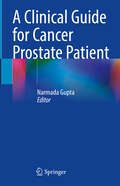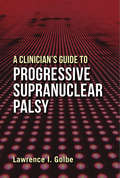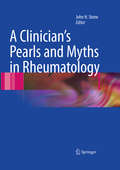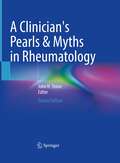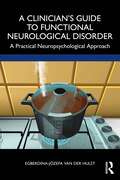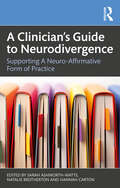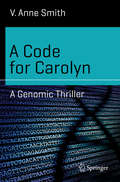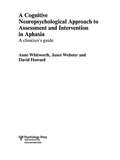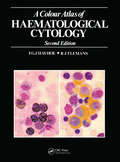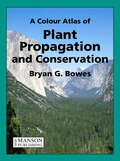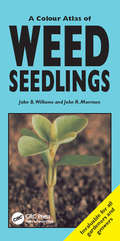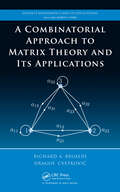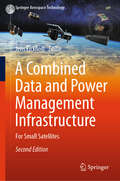- Table View
- List View
A Climate for Change
by Katharine Hayhoe Andrew FarleyMost Christian lifestyle or environmental books focus on how to live in a sustainable and conservational manner. A CLIMATE FOR CHANGE shows why Christians should be living that way, and the consequences of doing so. Drawing on the two authors' experiences, one as an internationally recognized climate scientist and the other as an evangelical leader of a growing church, this book explains the science underlying global warming, the impact that human activities have on it, and how our Christian faith should play a significant role in guiding our opinions and actions on this important issue.
A Clinical Guide for Cancer Prostate Patient
by Narmada GuptaThis book imparts a thorough understanding of the proper diagnosis, evaluation, and management of a patient with prostate cancer. The book provides guidelines for evaluation and investigation to reach a diagnosis with appropriate risk stratification of the disease, which is essential to evaluate the patient's survival and quality of life after the treatment. The book offers assistance, as per the patient and disease factors, appropriate treatment planning for an individual patient, and treatment outcomes for a better follow-up. This book aims to cover all aspects of prostate cancer with an additional supplement to the existing books in urology. This book targets postgraduates in urology, oncology, uro-oncology, practicing urologists, oncologists, and prostate cancer patients to know all aspects of the disease.
A Clinical Lens on Pediatric Engineering: Pioneering Science and Technology for Cutting-Edge Patient Care
by Jamie Leigh WellsA Clinical Lens on Pediatric Engineering: Pioneering Science and Technology for Cutting-Edge Patient Care explores the depth and breadth of the newly applied science of pediatric engineering and its dawning era. Placing into context the origins of pediatric medicine and engineering, this deep dive into and beyond medical digital-to-device innovation integrates scientific rigor with clinical perspective, incorporating case examples of diagnostic and therapeutic breakthroughs, cautionary tales, and lessons in translation. The book begins by explaining the unique considerations of the developing child and the importance of including nuanced end-user and human factors early and often in the process of seeking biomedical solutions. It provides an overview of this population's diverse and dynamic biopsychosocial characteristics compared to adults, contrasting organ systems, cognitive maturation, bioethics, growth, and drug metabolism. A distinguished team of contributors supplies a comprehensive blueprint for transforming an idea through to clinical implementation, featuring the ever-expanding influences and intricacies of discovery. The book covers a wide array of topics, including fetal intervention, transplantation, regenerative medicine, addiction, ophthalmology, surgery (e.g., minimally invasive, orthopedic), cancer, nanotechnology, radiology imaging modalities, gene therapy, artificial intelligence (AI), machine learning, liquid biopsy, immersive technologies (e.g., augmented and virtual reality), neurodiversity, rare disease, critical care, robotics, materials science and tissue engineering. The design challenges specific to children’s hospitals and healthcare facilities are discussed, highlighting the flexibility needed to achieve optimal patient outcomes, gather meaningful data, and drive innovative progress. This landmark work calls on key stakeholders to address the obstacles related to funding practices, clinical trials, and other impediments that hinder the timely and safe delivery of life-altering and life-saving results. It provides child health innovators with the essential tools to bridge these gaps and drive transformation in the rapidly evolving landscape of pediatric care.
A Clinician's Guide to Progressive Supranuclear Palsy
by Lawrence I. GolbeThis brief, clinically-focused volume is informed by Lawrence I. Golbe’s three decades of research and tertiary clinical care in progressive supranuclear palsy, a complex disorder with rapidly changing diagnostic and therapeutic approaches. It is an ideal source for the general neurologist seeking a refresher and the primary care provider, neurological nurse, or physical, occupational or speech therapist who must address their patients’ specialized needs. A Clinician’s Guide to Progressive Supranuclear Palsy emphasizes early diagnostic signs, medication options, non-pharmacologic management and palliative care. It offers a quick overview of the complications of PSP most likely to prompt an ER visit; a widening spectrum of PSP variants; and ample description of the genetics, epidemiology, natural history, pathology, molecular biology and neurochemistry of PSP. The PSP Rating Scale used in the book is a convenient tool for clinicians in routine practice and the leading PSP clinical measure world-wide. Golbe provides a practical and useful guidebook to help all clinicians learn and battle this complex disorder.
A Clinician's Pearls & Myths in Rheumatology
by John H. StoneImportant strides have been made in understanding the pathophysiologic basis of many inflammatory conditions in recent years, but rheumatology remains a discipline in which diagnosis is rooted in the medical history skillfully extracted from the patient, the careful physical examination, and the discriminating use of laboratory tests and imaging. Moreover, selection of the most appropriate therapy for patients with rheumatic diseases also remains heavily reliant upon clinical experience. Medical disciplines such as rheumatology that depend significantly upon clinical wisdom are prone to the development of systems of 'Pearls' and 'Myths,' related to the diseases they call their own, a 'Pearl' being a nugget of truth about the diagnosis or treatment of a particular disease that has been gained by dint of clinical experience and a 'Myth' being a commonly held belief that influences the practice of many clinicians - but is false. This book will pool together the clinical wisdom of seasoned, expert rheumatologists who participate in the care of patients with autoimmune diseases, systemic inflammatory disorders, and all other rheumatic conditions.
A Clinician's Pearls & Myths in Rheumatology
by John H. StoneThis book builds upon the first edition with new and improved chapters. The book explores the rich assemblage of clinical wisdom from expert rheumatologists from a wide range of specialties including Vasculitis and Sjogren’s syndrome. It examines the nuggets or ‘pearls’ of wisdom gained from collective clinical experience about the diagnosis or treatment of various diseases whilst also aiming to debunk myths that have influenced the practice of rheumatology by many clinicians. The second edition of A Clinician's Pearls and Myths in Rheumatology is a critical resource for both practitioners and students of rheumatology. This book provides a clear guide for those wishing to take a “deep dive” into the diagnostic and therapeutic elements of rheumatology.
A Clinician’s Guide to Functional Neurological Disorder: A Practical Neuropsychological Approach
by Egberdina-Józefa van der HulstThis manual for clinicians presents a ground-breaking, accessible and unifying new model for understanding functional neurological disorder (FND) that bridges the gap between theoretical FND-specific models and the more practical, but non-FND-specific Cognitive Behavioural Therapy (CBT) models. Grounded in psychology, the Pressure Cooker Model provides a clear metaphor for FND, focusing on intra-individual and inter-individual cognitive, emotional and behavioural processes. Developed based on years of clinical experience in the field, it is applicable to the assessment and treatment of every type of FND. Viewed as a systemic condition with unique psychosocial features, the book will describe the rationale for radically transforming FND recovery by providing a treatment model that aims to resolve emotion dysregulation processes and repair relationships between the person and the system. It uses a unifying framework to guide the steps of intervention and can be adapted for work in a multidisciplinary team context to facilitate communication between disciplines. Enriched with case studies and research data, the book also highlights a plethora of clinical tools and strategies based on the Pressure Cooker Model, as well as contextualising its position alongside CBT models. This manual is instrumental in educating and treating people with FND. It offers essential guidance for neuropsychologists, neuropsychiatrists and other health professionals, as well as students in these fields.
A Clinician’s Guide to Neurodivergence: Supporting a Neuro-Affirmative Form of Practice
by Sarah Ashworth-WattsA Clinician’s Guide to Neurodivergence: Supporting a neuro-affirmative form of practice is a concise handbook which provides a comprehensive and accessible overview of a range of conditions to support clinicians working with individuals with diverse neurocognitive profiles. It provides a practical guide for clinicians to move towards a more neuro-aware and neuro-affirmative way of working. It sets out guidance around diagnosis and access to services whilst giving consideration to the adaptations and accommodations that might be necessary to avoid the inequities that can often be experienced through neuro-normative or heteronormative practices.Topics covered include learning difficulties such as Dyslexia and Dyscalculia, Autism, ADHD, acquired brain injury and various other neurodivergent profiles. The intersection of neurodivergence with factors such as gender and age and comorbidity with mental health and personality profiles are also considered. Drawing on the NICE guidelines, the International Classification of Disease (ICD) system, and the Diagnostical Statistical Manual (DSM), each chapter provides the background to different neuro-cognitive profiles, common indicators that may be observed, screening and diagnostic assessment, clinical recommendations and signposting to relevant resources and services.It is valuable reading for students, researchers, clinicians, therapists, medical and allied professionals who require an introductory text providing in-depth details regarding a range of neurodivergent conditions.
A Code for Carolyn: A Genomic Thriller (Science and Fiction)
by V. Anne SmithCarolyn’s parents did not, after all, make genomics history by synthesizing her genome in a lab. She has known she is the "Human Hoax" ever since a high school genetics exercise revealed she has trisomy X—a chromosomal abnormality—yet no synthetically constructed genome would have such clear traces of natural conception. Many years later, as molecular biologist, she hopes her colleagues never learn of her embarrassing origins. But when someone ransacks her office and lab, she finds professional embarrassment is the least of her worries. Someone believes she has the results of her parents’ last, secret experiments, and is willing to kill to get them. But all she has from her parents are their genes—can she find what else they may have left her before somebody else does? In a not-so-distant society, where corporations wield as much power as nations and the line between corporate employee and state authority is blurred, the chase is on. Carolyn may have just too little time at hand to unravel the mystery of her parents’ final days and to realize the deep consequences for the future of mankind. This fast-paced novel is followed by an extensive science chapter where the author provides a non-technical primer on modern genetics and on the speculative biology behind Carolyn’s code.
A Cognitive Ethnography of Knowledge and Material Culture: Cognition, Experiment, and the Science of Salmon Lice (Culture, Mind, and Society)
by Mads SolbergThis cognitive ethnography examines how scientists create meaning about biological phenomena through experimental practices in the laboratory, offering a frontline perspective on how new insights come to life. An exercise in the anthropology of knowledge, this story follows a community of biologists in Western Norway in their quest to build a novel experimental system for research on Lepeoptheirus salmonis, a parasite that has become a major pest in salmon aquaculture. The book offers a window on the making of this material culture of science, and how biological phenomena and their representations are skillfully transformed and made meaningful within a rich cognitive ecology. Conventional accounts of experiments see their purpose as mainly auxiliary, as handmaidens to theory. By looking closely at experimental activities and their materiality, this book shows how experimentation contributes to knowledge production through a broader set of epistemic actions.In drawing on a combination of approaches from anthropology and cognitive science, it offers a unique contribution to the fields of cultural psychology, psychological anthropology, science and technology studies and the philosophy of science.
A Cognitive Neuropsychological Approach to Assessment and Intervention in Aphasia: A Clinician's Guide
by David Howard Anne Whitworth Janet WebsterThis book provides both a theoretical and practical reference to cognitive neuropsychological approaches to speech and language therapists working with people with aphasia. Having evolved from the activity of a group of clinicians working with people with aphasia, it is a highly practical guide that aims to interpret the theoretical literature as it relates to aphasia and link it directly to available assessment tools and therapy techniques. The opening section of the book provides an overview of the theory underpinning the approach and how it can be applied to the assessment and interpretation of language-processing impairments. The second section offers a working explanation of different components of language processing, outlining the deficits that may arise from impairment to each component. In addition, the clinician is guided to available assessments to test out clinical hypotheses and offered interpretations of performance patterns. The final section provides a comprehensive overview of the therapy literature with systematic summaries of the therapies undertaken and a synthesis of the findings to date. This book has been written by clinicians with hands-on experience. It will be an invaluable resource for clinicians and students of speech and language therapy and related disciplines.
A Cognitive Neuropsychological Approach to Assessment and Intervention in Aphasia: A clinician's guide
by David Howard Anne Whitworth Janet WebsterThis is a second edition of the highly popular volume used by clinicians and students in the assessment and intervention of aphasia. It provides both a theoretical and practical reference to cognitive neuropsychological approaches for speech-language pathologists and therapists working with people with aphasia. Having evolved from the activity of a group of clinicians working with aphasia, it interprets the theoretical literature as it relates to aphasia, identifying available assessments and published intervention studies, and draws together a complex literature for the practicing clinician. The opening section of the book outlines the cognitive neuropsychological approach, and explains how it can be applied to assessment and interpretation of language processing impairments. Part 2 describes the deficits which can arise from impairments at different stages of language processing, and also provides an accessible guide to the use of assessment tools in identifying underlying impairments. The final part of the book provides systematic summaries of therapies reported in the literature, followed by a comprehensive synopsis of the current themes and issues confronting clinicians when drawing on cognitive neuropsychological theory in planning and evaluating intervention. This new edition has been updated and expanded to include the assessment and treatment of verbs as well as nouns, presenting recently published assessments and intervention studies. It also includes a principled discussion on how to conduct robust evaluations of intervention within the clinical and research settings. The book has been written by clinicians with hands-on experience. Like its predecessor, it will remain an invaluable resource for clinicians and students of speech-language pathology and related disciplines, in working with people with aphasia.
A Color Atlas of Comparative Pathology of Pulmonary Tuberculosis
by Franz Joel Leong Véronique Dartois Thomas DickAn annual death toll of 2 million, coupled with rising drug resistance, highlights the need for the development of new drugs, better diagnostics, and a tuberculosis (TB) vaccine. Addressing these key issues, A Color Atlas of Comparative Pathology of Pulmonary Tuberculosis introduces TB histopathology to the non-histopathologists, students, scientis
A Color Atlas of the Chinese Mecoptera
by Ji-Shen Wang Bao-Zhen HuaIn this atlas, 242 species of the Chinese Mecoptera are illustrated. For most species, the present pictures of the adults and the male genitalia are provided and a geographical distribution map is also available for every species. This book is aiming at not only the audiences such as general entomological researchers and hobbyists but also the forefront workers in the disciplines of agriculture and forestry as a practical reference.
A Colorful Introduction to the Anatomy of the Human Brain: A Brain and Psychology Coloring Book
by John P.J. Pinel Maggie E. EdwardsThousands of people inquire about and buy a competitor to this book each year. Unique layout compared to the competition! Text is on the left page with illustration on facing page. A cover flap can cover the illustration's labels for easy self-testing. Up-to-date information covers the latest findings. Available now! Acknowledging the difficulty many readers have when first attempting to learn about the brain's psychological functions, the authors of A Colorful Introduction to the Human Brain have created a book that makes the fascinating world of brain psychology research accessible to readers with little or no background in neuroscience. Readers learn the material in several steps. First they read through the introduction and definitions on the left page; then they color the illustration on the facing page; and finally they use the special cover flap to conceal the illustration labels while checking their knowledge, until they feel they have completely learned the material. Review exercises at the end of each chapter provide an opportunity for self-assessment, with answers provided at the end of the book. <P><P> John Pinel, a professor of biopsychology at the University of British Columbia, is an award-winning teacher and the author of over 200 scientific articles. However, he is best known for his reader-oriented writing. His clear concise introductions to behavioral neuroscience have inspired, enthralled, and amused a generation of students and lay people.
A Colour Atlas of Haematological Cytology
by Hayhoe/FlemansThe second edition of this atlas has been revised and greatly en-larged to take account of recent diagnostic advances in the field of haematology. It contains 750 color photomicrographs of common and less common cell types, and is intended to supplement the per-sonal study of preparations under the microscope.The photographs are grouped into five sections covering red cells and their precursors; nonerythroid cells of myeloid origin; lympho-cytes, plasma cells and their derivatives and precursors; miscella-neous cells of blood and marrow, including foreign cells and para-sites; and the imprint cytology of lymph nodes and spleen. Each section is preceded by a brief introduction, and an appendix pro-vides technical details of staining methods. The text accompanying the illustrations serves chiefly to identify the cells, but also gives explanations of certain unusual appearances and the cytochemical reactions where necessary.A Colour Atlas of Haematological Cytology will be useful to students of medicine and medical laboratory science, as well as to doctors and technicians specializing in the diagnosis of haematological disease.
A Colour Atlas of Plant Propagation and Conservation
by Bryan BowesWhile scientific and socio-political communities around the world are aware of the natural and economic importance of biodiversity, we are faced with an ever-increasing number of plant species under threat of extinction. Conservation is thus a vital part of the plant scientist's work, in the field, in botanic gardens and in universities.This colour
A Colour Atlas of Salmonid Diseases
by David W. Bruno Patricia A. Noguera Trygve T. PoppeSalmonids have widespread economic and environmental importance. Correct identification and understanding of their diseases are therefore vital if valuable stocks are to be maintained. This volume provides a practical guide and an aid to disease recognition. This is an updated and extended version of the first publication in 1996 and contains around 400 high quality colour photomicrographs.
A Colour Atlas of Weed Seedlings (Manson Ser.)
by John B WilliamsEarly recognition and control of weeds invariably leads to considerable savings in the cost of herbicides used on crops and in gardens. This atlas is an indispensable full colour photographic guide to the 40 most common weeds afflicting arable farmland and gardens. The weeds have all been photographed at cotyledon and seedling stage to permit early
A Combinatorial Approach to Matrix Theory and Its Applications (Discrete Mathematics and Its Applications)
by Richard A. Brualdi Dragos CvetkovicUnlike most elementary books on matrices, A Combinatorial Approach to Matrix Theory and Its Applications employs combinatorial and graph-theoretical tools to develop basic theorems of matrix theory, shedding new light on the subject by exploring the connections of these tools to matrices. Placing combinatorial and graph-theoretical tools at the forefront of the development of matrix theory, this book uses graphs to explain basic matrix construction, formulas, computations, ideas, and results. It presents material rarely found in other books at this level, including Gersgorin's theorem and its extensions, the Kronecker product of matrices, sign-nonsingular matrices, and the evaluation of the permanent matrix. The authors provide a combinatorial argument for the classical Cayley-Hamilton theorem and a combinatorial proof of the Jordan canonical form of a matrix. They also describe several applications of matrices in electrical engineering, physics, and chemistry.
A Combinatorial Perspective on Quantum Field Theory (SpringerBriefs in Mathematical Physics #15)
by Karen YeatsThis book explores combinatorial problems and insights in quantum field theory. It is not comprehensive, but rather takes a tour, shaped by the author's biases, through some of the important ways that a combinatorial perspective can be brought to bear on quantum field theory. Among the outcomes are both physical insights and interesting mathematics. The book begins by thinking of perturbative expansions as kinds of generating functions and then introduces renormalization Hopf algebras. The remainder is broken into two parts. The first part looks at Dyson-Schwinger equations, stepping gradually from the purely combinatorial to the more physical. The second part looks at Feynman graphs and their periods. The flavour of the book will appeal to mathematicians with a combinatorics background as well as mathematical physicists and other mathematicians.
A Combined Data and Power Management Infrastructure: For Small Satellites (Springer Aerospace Technology)
by Jens EickhoffThis book describes the development and design of a unique combined data and power management infrastructure for small satellites. This new edition became necessary because in the frame of the system's impressive evolution from an academic prototype to one of today's most advanced core avionics, many elements were upgraded to their next technology generation and diverse new components complement the upgraded design. All elements are presented in updated respectively new chapters. This modular infrastructure was selected by the Swiss start-up ClearSpace SA for ESA's first mission ClearSpace-1 to remove space debris. Furthermore it is the baseline for the Thai national satellite development program and is used by an increasing number of universities worldwide for research studies.
A Comet of the Enlightenment: Anders Johan Lexell's Life and Discoveries (Vita Mathematica #17)
by Johan C.-E. SténThe Finnish mathematician and astronomer Anders Johan Lexell (1740-1784) was a long-time close collaborator as well as the academic successor of Leonhard Euler at the Imperial Academy of Sciences in Saint Petersburg. Lexell was initially invited by Euler from his native town of Abo (Turku) in Finland to Saint Petersburg to assist in the mathematical processing of the astronomical data of the forthcoming transit of Venus of 1769. A few years later he became an ordinary member of the Academy. This is the first-ever full-length biography devoted to Lexell and his prolific scientific output. His rich correspondence especially from his grand tour to Germany, France and England reveals him as a lucid observer of the intellectual landscape of enlightened Europe. In the skies, a comet, a minor planet and a crater on the Moon named after Lexell also perpetuate his memory.
A Common Operating Picture for Air Force Materiel Sustainment
by Robert S. Tripp Kristin F. Lynch Patrick Mills Don Snyder Raymond A. PylesDescribes a potential common operating system (COP) for the Air Force materiel sustainment system (MSS). The authors first develop a COP based on the principles of effects-based measures, schwerpunkt (organizational focus), decision rights, and a nonmarket economic framework, then they apply the COP to depot-level reparable component sustainment to illustrate how the COP would improve overall MSS efficiency and responsiveness.
A Commotion in the Blood: Life, Death, and the Immune System (The Sloan Technology Series)
by Stephen S. HallIn this layman's history of immunology, Stephen S. Hall traces the story of how doctors have learned to harness the immune system and its "commotions" in the blood to develop new approaches to the treatment of cancer. He portrays the doctors and research scientists of note, starting with William Coley in the late 1890s, who have contributed to modern understanding of immunology while uncovering the roles of interferon, interleukins, T cells, B cells, necrosis factors, and more. He brings to life the sometimes contentious personalities and organizations involved in the race to find a miracle cure for cancer, and explores the experimental trials of a wide array of cutting-edge therapies through 1997, the date of publication.

